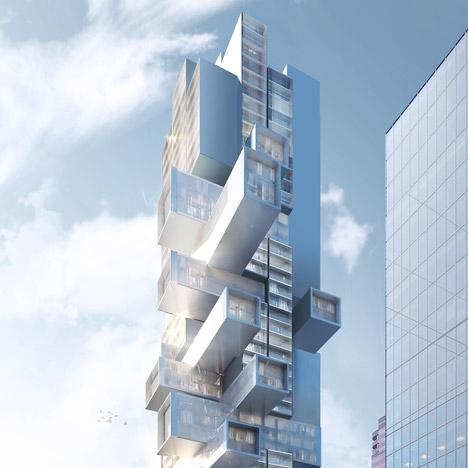Comments update: readers have been discussing the use of irregularly stacked boxes in architectural projects this week, responding to the first images of Ole Scheeren's Vancouver skyscraper design and BIG's proposal for the Two World Trade Center site in New York. Read more on these and the other most commented stories on Dezeen.
Stacked up: Ole Scheeren's Vancouver skyscraper will feature a series of apartments protruding from the facade to create a clustered form, which was described by the Beijing-based architect as a "new typology for vertical living". Not everyone agreed with this assessment.
"[He has] extruded a few apartments here and there," said Dylan. "This isn't a new typology, it's messing around with a computer model."
"All this talk about connecting [the structure] to its context, and yet the formal innovation only works from the exterior," agreed Loewen.
"I wouldn't call it a new typology, but an interesting move to attempt a new engagement with the urban context," added Jon C. Read the comments on this story »
Building blocks: BIG's design for the World Trade Center site in New York was described by the Danish architecture firm as a "new hybrid" that merges the Modernist skyscraper with a contemporary interpretation of historic buildings. The stacked-volume building prompted an equally strong response.
"All these 'bold' megalomaniac approaches to tall buildings need to stop and for once be looked at from the macro level," said Kay.
"I love BIG's style for diagrammatically approaching design and tackling the obvious problems up front," added Chris MacDonald. "But I don't think it has worked here."
One reader even likened the building's shape to fictional monster Godzilla, but others found the design to be refreshingly simple and relevant to its context.
"Simple diagrams, clear contextual reference and just enough difference to stand the test of time and not look too wacky," said Keith Dougal. Read the story and comments »
Bridge bots: commenters were excited by plans for a pedestrian bridge in Amsterdam that will be 3D printed by robots.
"Finally people who are taking true advantage of robots," said Jeroen van Lith. "High-res lean structures, no assembly and on-site fabrication."
"Such a beautiful, mathematically optimised and load-bearing structure," added an enthusiastic DoRightThing. "The next step would be to weave and cure continuous carbon-fibre structures... it could make space elevators possible." Read the comments on this story »
Drone alone: Superflux built a series of drones, which the London studio suggested could be used in cities for surveillance, traffic control and advertising.
"How about using them for something to help people rather than control them and invade their privacy?" asked Chris.
"Truly progressive design should be considering the possibility of a world where we aren't surrounded by surveillance and advertising," said regular Dezeen commenter generalpopulation.
Others felt the project highlighted important issues surrounding the future use of technology.
"Aptly shows how horrifying the technology could be," wrote Robert. "The complete loss of anonymity in public space is something citizens should not allow." Read the comments on this story »

